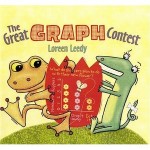 When I was a kid, my brother and I would empty out our bags after trick-or-treating on Halloween and divide the candy into piles: lollipops, bubble gum, candy we were willing to trade, favorites that would be hoarded, etc. I kept careful count of how many of each of my favorites I had, to make sure I’d know if one went missing (my brother was sneaky.) If I’d only had access to The Great Graph Contest by Loren Leedy when I was little, I could’ve made the best kind of bar graph – a candy bar graph – and organized all my trick-or-treat information with real-life math practice.
When I was a kid, my brother and I would empty out our bags after trick-or-treating on Halloween and divide the candy into piles: lollipops, bubble gum, candy we were willing to trade, favorites that would be hoarded, etc. I kept careful count of how many of each of my favorites I had, to make sure I’d know if one went missing (my brother was sneaky.) If I’d only had access to The Great Graph Contest by Loren Leedy when I was little, I could’ve made the best kind of bar graph – a candy bar graph – and organized all my trick-or-treat information with real-life math practice.
In The Great Graph Contest by Loren Leedy, a toad and a lizard compete to see who can make the best graphs. Leedy introduces bar graphs, picture graphs, pie charts, and Venn diagrams simply and with a sense of humor. Your class can use the information on making graphs to practice math with a subject they will find inherently interesting – their candy.
So, share the book with your students (noting with pride how easily you are working the Common Core State Standard of Range of Reading into your curriculum.) Next, get your hands on some candy. You can have students bring in some from home, you can steal from your own kids’ Halloween stash, you can get an assorted bag from the store – if lots of candy in the classroom doesn’t sound like a sweet deal to you, have students just bring in wrappers.
Talk about the different kinds of graphs found in the book, and which would be best suited to organize information about your candy. Sort candies by color of wrapper, ingredients, by beginning letter, etc. Paste wrappers to make a picture graph, or create bar graphs if you have large amounts. Make Venn Diagrams for things like “candies with chocolate”, “candies with nuts” and which candies would be the union. Graphing candy makes for a sweet math activity!
For more information, visit Loren Leedy’s website at: lorenleedy.com.